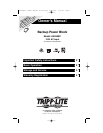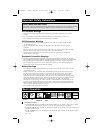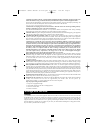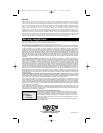
3
2
4
3
5
6
7
8
CAUTION! To perform a self-test, you must hold the ON/OFF/TEST button continuously for three seconds; if you
release the button too early, you will turn the UPS system OFF and cut power to connected equipment loads.
The test will last approximately 10 seconds as the UPS switches to battery to test its load capacity and charge. All
LEDs will be lit. See LED descriptions below to determine the results of the Self-Test.
Note: You can leave connected equipment on during a self-test.
CAUTION! Do not unplug your UPS to test its batteries. This will remove safe electrical grounding and may
introduce a damaging surge into your network connections.
The ON/OFF/TEST Button also functions as a recycle/reset button with sequential outlet startup (including
approximately 60 second router outlet delay) for proper modem and router rebooting.
“ON/OFF” LED: This green LED lights continuously to indicate that the UPS is ON and supplying your equipment
with AC power either from a utility source or from the UPS’s internal batteries.
“OVERLOAD/CHECK BATTERY” LED: This red LED lights continuously after a self-test to indicate the
capacity of the battery-supported outlets has been exceeded. To clear the overload, unplug some of your equipment
from the battery-supported outlets; then use the ON/OFF/TEST button to run a Self-Test. If the UPS continues to
detect an overload, remove more equipment and repeat the self test until successful.
CAUTION! Any overload that is not corrected by the user immediately following a self-test may cause the
UPS to shut down and cease supplying output power in the event of a blackout or brownout. The LED flashes
to indicate the battery needs to be recharged or replaced. If the LED flashes during a prolonged blackout or
brownout, the UPS’s batteries are nearly out of power; you should save files and shut down your equipment
immediately. If the LED flashes following a UPS self-test (after the UPS is turned ON), it may indicate that
the battery needs to be replaced. Allow the UPS to recharge continuously for 12 hours; then use the
ON/OFF/TEST button to run a Self Test. If the LED continues to flash, contact Tripp Lite for service. Should
your UPS require battery replacement, visit Tripp Lite on the web at www.tripplite.com/support/
battery/index.cfm to locate the specific replacement battery for your UPS.
Battery Backup Protected/Surge Protected Outlets: These four outlets provide both battery backup and surge
protection. Plug your modem, router, RF amplifier and other equipment into these outlets. The outlet labeled
"ROUTER" features a delay start function. This outlet will turn on approximately 60 seconds after the unit powers
up. Use this outlet for a router or any other device you wish to start up approximately 60 seconds after other
connected equipment.
Tel/DSL Line Protection Jacks: These jacks protect equipment against surges over a single phone line. Select
models feature a built-in splitter (one jack in/two jacks out), allowing you to connect two devices sharing a single
line. Connecting your equipment to these jacks is optional. Your UPS will work properly without this connection.
HD-Compatible 22GHz Coax Protection Jacks: Gold coaxial "F" connectors protect connected equipment by
stopping surges on a single DSS satellite, cable or antenna line. Connect a coaxial cable from the wall jack directly
to the coaxial jack labeled "IN." Connect a coaxial cable from the coaxial jack labeled "OUT" directly to the device
to be protected. The UPS system must always be the first item connected in line from the coaxial wall jack. The UPS
system must be plugged into a 3-wire grounded AC outlet for coaxial line surge protection to work. Make sure coax
cables connected to satellite dishes, antennas, etc. are also grounded. Connecting your equipment to these jacks is
optional. Your UPS will work properly without this connection.
Resettable Input Circuit Breaker: Protects your electrical circuit from overcurrent draw from the UPS load. If this
breaker trips, remove some of the load, then reset it by pressing it in.
Regulated 12V DC Connector: This connector provides an additional power source for 12V DC devices. It features
a delay start function and will turn on approximately 60 seconds after the unit powers up.
NOTE: Observe polarity (+/-) before connection. Do not exceed 1 amp draw.
Steps for proper wiring of male connector:
1. Strip wire to appropriate length.
2. Insert small screwdriver into slot on crimping button.
3. Insert wire into the hole.
4. Release screwdriver.
Storage and Service
Storage
To avoid battery drain, all connected equipment should be turned off and disconnected from the UPS. Press and hold
the ON/OFF/TEST switch for one second. Your UPS will be completely turned off (deactivated), and will be ready for
storage. If you plan on storing your UPS for an extended period, fully recharge the UPS batteries every three months.
Plug the UPS into a live AC outlet, turn it on by pressing and holding the ON/OFF/TEST switch for one second, and
allow the batteries to recharge for 4 to 6 hours. If you leave your UPS batteries discharged for a long period of time,
they will suffer a permanent loss of capacity.
200706062- Owners Manual 93-2710.qxd 8/20/2007 1:46 PM Page 3






